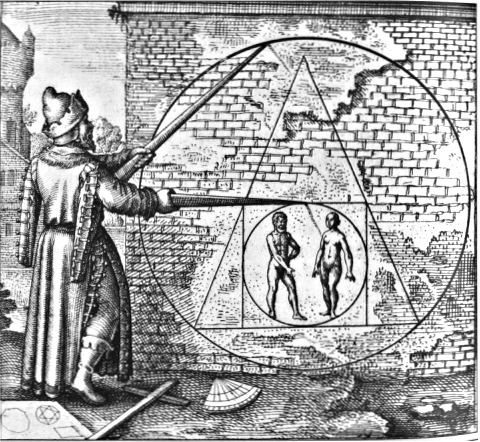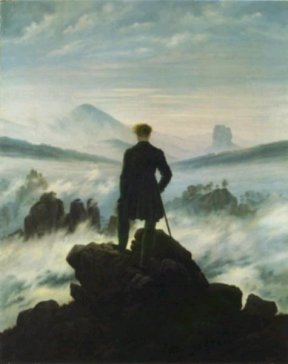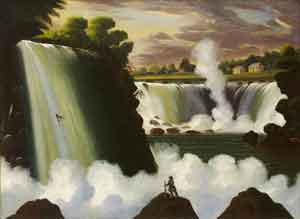Ideas about nature first started to change in the late 1700s and more clearly in the 1800s. Europeans began to admire (from a distance) the wilderness in North America and a few Americans who lived in cities picked up this idea (actually settlers on the frontier still saw wilderness simply as something to be conquered).
Both the Enlightenment and the people who reacted against it (Romantics) developed more positive views of wilderness. The idea that wilderness was good was spreading, but it took several different forms.
The Enlightenment was an intellectual movement in the 18th century. The scientific revolution got people excited that we can understand the world through science. This led to an emphasis on finding better ways of doing things, instead of tradition. This was very influential on the American revolution and the constitution.
New ways of seeing nature resulted from the enlightenment, in three rather contradictory ways.
- the enlightenment
led some
intellectuals to Deism:
an
approach to religion that focuses on God
as the creator of
the world, rather than emphasizing God intervening in
our daily lives
(and if you focus on God as creator then the creation
becomes an
important way of knowing God). God is a perfect
watchmaker who
made the creation work so well that God doesn't need to
interfere.
- the development of
science
led to the idea of natural
theology, a different approach that lead to the
idea that
studying nature was a way to
get closer to God, popular even among some evangelicals
- The Romantic movement
in
Europe was a reaction against the idea that science can
explain everything, that everything is rational.
It led to an
enthusiasm for whatever was wild and
mysterious. God is in the mysterious and can't be
understood so
is a very personal experience.
- Science started
out in
conflict with religion at the time of the scientific
revolution
- Galileo was the first to use experiment to gain scientific knowledge--can show by an experiment that Aristotle is wrong--experience trumps authority
- Copernicus
published the
theory that the earth goes around the sun, fifty
years later Galileo
found evidence to support it
- got in trouble with church over whether the Copernican theory contradicted the bible
- "Tell it out among the
nations:
"The LORD is King!
he has made the world so firm that it cannot be moved;" (Psalm 96:10)
- Galileo
tried to explain another passage, in which God told
the
sun to stand still (Joshua 10:12-14) in order to
make the day
longer. But if the length of the day is caused
by the earth's
rotation then telling the sun to stand still won't
make the day
longer. Galileo explained that God was telling
the sun to stand
still so both sun and earth would stop
rotating.
- Galileo got in trouble for coming up with his own interpretation of the Bible
- first Galileo
forbidden
to teach
the Copernican theory, then confined to house arrest
and required to
abjure the theory
- is the source of
truth
authority (Bible and teachings of church) or
experience (experiment)
- despite these
early
conflicts between science and religion, as science
became more and
more successful, people began to look for ways to put
the two together
- the development of science made people more interested in nature and showed the natural world to be complex and impressive
- this led to the idea that studying science was a way to admire the handiwork of God
- one argument they used is if you discover a watch the best explanation is that there must be a watchmaker (William Paley)
- more emphasis on
the idea
that we learn more about God by studying the wonderful
things he
created--these people tended to believe that the more
science they
studied the better Christians they would be
- Hitchcock (gravestone below) was a professor of geology (and then president) of Amherst College and a Congregationalist minister
- believed that
everything he
could learn as a scientist would support his religious
beliefs
- people believed they could come closer to God both by reading the Bible and by knowing better the glorious works of the creator--the book of nature as it was before human beings tamed it
 +
+Romanticism: A literary and artistic movement that encouraged an interest in the strange, remote, solitary, and mysterious, instead of wanting to make the world as well-ordered as possible.
- Romantics didn't
want to
understand everything rationally, they were interested
in what couldn't
be understood
- Romantics weren't sure that civilization had indeed made us happier, but instead admired primitive people
- they were more interested in feelings and imagination and less interested in rationality
- they saw feelings as wild and identified rationality with civilization
- they were interested in those things that cannot be understood rationally
but Romantics popularized several ideas that were more widely influential
- they had a new idea of how
nature
is beautiful
- Sublime: natural beauty that was not neat and well-ordered like a garden but complex, uncontrollable and impressive, leading to feelings of awe.
- beauty that changes the viewer, that brings the viewer in touch with God or some greater truth
- experiencing nature
creates
awe for God's creation and becomes a form of worship
- An emphasis on the
individual character of different nations (romantic
nationalism)
Copying European ideas, a few Americans began to write of wilderness as beautiful. This was new--it seems obvious to us but people really hadn't written about it that way before.
Art promoted this way of seeing nature:



